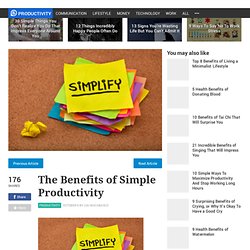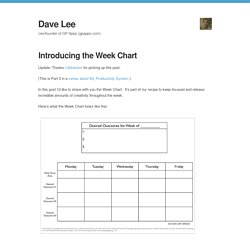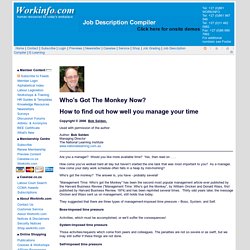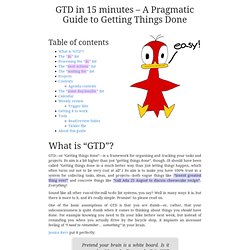

Time Management. Delegation Skills. 5 Performance Management Trends for 2015 - OKRs and Continuous Performance Management. Are you ready to transform your workplace in 2015?

Or are you doomed to repeat the same performance management process that failed to deliver value to your employees and your organization? Revamping your performance management can be frightening for some. Especially if you’ve always relied solely on annual performance reviews (which we know don’t work). Yet, performance management isn’t the same thing as a performance review. So unless you’ve already included coaching, feedback, motivation, engagement, and improvement in your process, you’ve failed. 50 Tricks to Get Things Done Faster, Better, and More Easily. Achieve More With Less In Life Using 80/20 Principle. By Celes on Jan 9, 2009 | ShareThis Email This Post.

Understanding the Pareto Principle (The 80/20 Rule) Originally, the Pareto Principle referred to the observation that 80% of Italy’s wealth belonged to only 20% of the population.

More generally, the Pareto Principle is the observation (not law) that most things in life are not distributed evenly. It can mean all of the following things: 20% of the input creates 80% of the result20% of the workers produce 80% of the result20% of the customers create 80% of the revenue20% of the bugs cause 80% of the crashes20% of the features cause 80% of the usageAnd on and on… Mini-Retirement Week 1: Time Management.
The past 4 years have been a blur operating, expanding and managing The Hostel Crowd.

I can speak for the entire team when I say that 24 hours in a day was never enough. We just bounced from one crisis to another. Somewhere along the way, a method to deal with the madness began to emerge. The method was not holistic and as ironic as it may sound – I never had the time to write about time management. 50 Tricks to Get Things Done Faster, Better, and More Easily. Benefits of Simplicity to Productivity. Simplicity is often perceived as boring, unattractive and unremarkable.

Majority of people want something striking and complicated. But as Leonardo da Vinci has said, Time Management Tips: How to Find the Right Mindset to Succeed With Time Management. For the past several years I have worked with time management techniques such as lists, prioritization, planning and so on.

But it wasn’t until I adopted a Quadrant 2 mindset that I really started seeing results. The phrase “Quadrant 2” comes from Stephen Coveys book The 7 Habits of Highly Effective People. How to Stop Being Lazy and Get More Done: 5 Expert Tips. Before we commence with the festivities, I wanted to thank everyone for helping my first book become a Wall Street Journal bestseller. To check it out, click here. Some days the to-do list seems bottomless. Just looking at it is exhausting. Dave Lee — Introducing the Week Chart.
Update: Thanks Lifehacker for picking up this post.

(This is Part 3 in a series about My Productivity System.) In this post I’d like to share with you the Week Chart. 50 Tricks to Get Things Done Faster, Better, and More Easily. The Zeigarnik effect: uncompleted tasks stay in mind until you finish them. If you, like us, are constantly looking for more efficient ways to work, then you will really appreciate what the Zeigarnik effect has to offer.
It carries the name of Bluma Zeigarnik, a Lithuanian-born psychologist who first described this effect in her doctoral thesis in the late 1920s. Some accounts have it that Zeigarnik noticed this effect while she was watching waiters in a restaurant. The waiters seemed to remember complex orders that allowed them to deliver the right combination of food to the tables, yet the information vanished as the food was delivered. Zeigarnik observed that the uncompleted orders seemed to stick in the waiters’ minds until they were actually completed.
Bluma Zeigarnik, 1921. Zeigarnik didn’t leave it at that, though. Managing Management Time: Who's got the Monkey? Who s Got The Monkey Now? How to find out how well you manage your time. Copyright © 2006 Bob Selden, Used with permission of the author: Author: Bob Selden Managing Director The National Learning Institute www.nationallearning.com.au Are you a manager?

Would you like more available time? GTD in 15 minutes – A Pragmatic Guide to Getting Things Done. GTD—or “Getting things done”—is a framework for organising and tracking your tasks and projects.

Its aim is a bit higher than just “getting things done”, though. (It should have been called “Getting things done in a much better way than just letting things happen, which often turns out not to be very cool at all”.) Its aim is to make you have 100% trust in a system for collecting tasks, ideas, and projects—both vague things like “invent greatest thing ever” and concrete things like “call Ada 25 August to discuss cheesecake recipe”. Everything! 11 Practical Ways To Stop Procrastination. You have a deadline looming.

However, instead of doing your work, you are fiddling with miscellaneous things like checking email, social media, watching videos, surfing blogs and forums. Chunking Information for Instructional Design. If we ran a contest for the favorite esoteric word of Instructional Designers, the term “chunking” might win. The Engagement Effect: Human Performance Improvement. What is Human Performance Improvement? The Human Performance Improvement process is very similar to Human Performance Technology. HPI provides you with a systematic process to follow on what can often be a not-so-systematic path.
In addition to identifying human performance gaps and their possible solutions, this standardized approach offers the ability to measure the success of your efforts and eliminate the guesswork that follows when a performance gap must be evaluated. HPI is results-based and systematic. Rather than focusing on a ‘wants-based’ or ‘needs-based’ approach, HPI follows a ‘results-based’ approach to improving performance, distinguishing it from many HRD (human resource development) activities. Techniques for Changing Minds. 5 Steps to Preventing Scope Creep (and Still Keeping Your Clients Happy) - Bidsketch.
Any freelancer or agency that has been in business for any length of time has experienced the monster that is scope creep. It goes something like this: work with a new client starts off as well as you would expect, but over time the project seems to get bigger and bigger while your price remains the same. The client either (a) seems to think5. How to Write Email with Military Precision. In the military, a poorly formatted email may be the difference between mission accomplished and mission failure.
During my active duty service, I learned how to structure emails to maximize a mission’s chances for success. Since returning from duty, I have applied these lessons to emails that I write for my corporate job, and my missives have consequently become crisper and cleaner, eliciting quicker and higher-quality responses from colleagues and clients. The Magic of Doing One Thing at a Time. How to Work 40 Hours in 16.7 (The Simple Technique That Gave Me My Life Back) I used to work a lot — 60, 80, or even 100 hours a week…
Jurgen Appelo Proposes the Chunking Productivity Technique. Jurgen Appelo, CEO at Happy Melly and author of the book Management 3.0, recently posted his new technique of work management called the chunking technique to increase productivity. What is Scrum? An Agile Framework for Completing Complex Projects. Scrum is an Agile framework for completing complex projects. How to Be More Productive: The Chunking Technique - NOOP.NL. A Better Way to Address Performance Issues. “Will or skill” is an insufficient question when addressing performance issues. Ten Steps for Creating a Culture of Commitment and Accountability. We all say that we want our people to be accountable and responsible for their actions, but are we doing what it takes to achieve these results?
Commitment Check: A Process for Enhancing Staff Performance. Helping staff members and colleagues enhancing organizational and individual performance is every leader’s responsibility. This responsibility is made easier if your company has developed and published clear position guidelines which include key functions and tasks as well as clear performance standards for each of the positions in your company. These guidelines and standards become the foundation for conducting skillful commitment checks, performance observations, assessments and coaching sessions as well as formal evaluations.
Productivity.